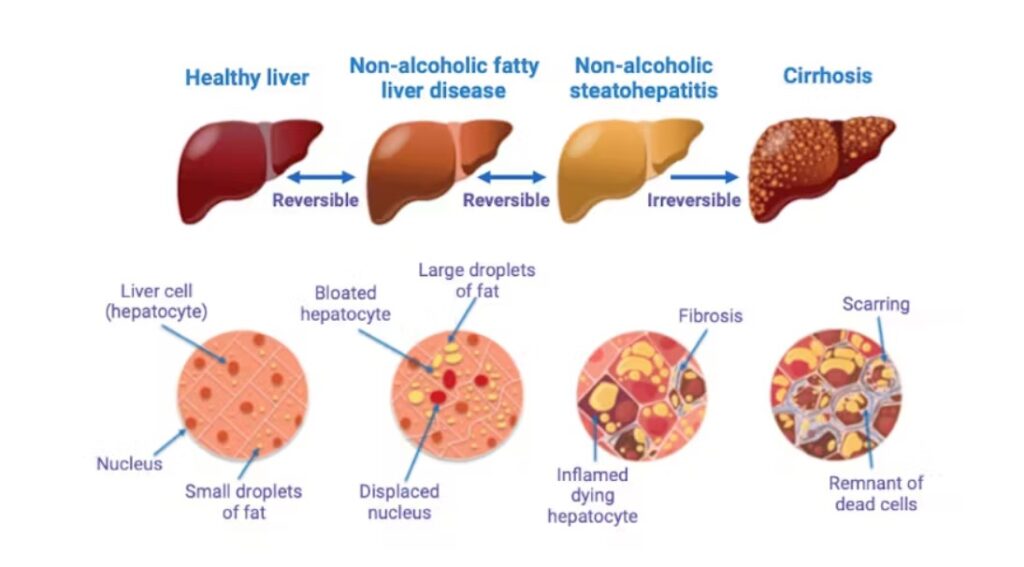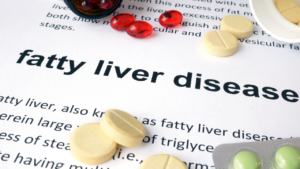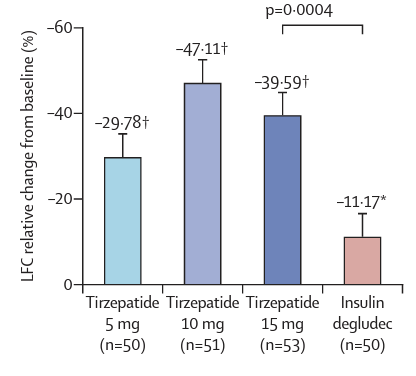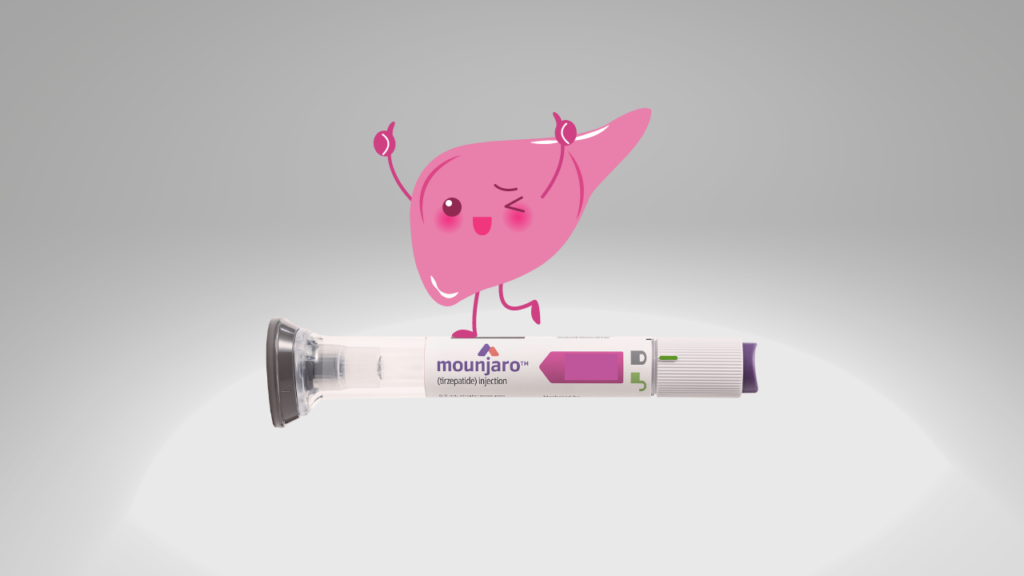The following is a transcript of the “Mounjaro can CURE Fatty Liver” video posted on YouTube.
Exploring Mounjaro’s Impact on Fatty Liver Disease
Can Mounjaro, the new GLP-1 GIP combination weight management medication, cure fatty liver disease. Now, if you’ve been here for a while, you know I’m not a big fan of the word cure, especially when it comes to chronic diseases. But I want to talk about today the effects that Mounjaro has on liver fat and treating liver fat disease and how it can potentially be an extensive, game-changing medication. So, we know that fatty liver or non-alcoholic fatty liver disease affects about one in four people worldwide. That’s 25% of the global population. Now, fatty liver is just like the name sounds. It’s an accumulation of fat within the liver; some fat is okay; there’s no problem with it. However, too much fat within the liver can lead to problems like inflammation and damage, which will be very harmful over time.

And ultimately, fatty liver disease is becoming the most common reason people either develop liver cancer or require a liver transplant. And for individuals that have diabetes or obesity, fatty liver can be pretty common. And to show you a nice little picture here (NIH), as you can see over my right-hand side, your left-hand side, we have a nice healthy liver; it’s looking good, it’s happy, everybody is doing their thing. As we progress over and closer to my head, we get more and more fat accumulation, which over time will cause more damage because ultimately, when too much fat accumulates within the liver cells, the liver cells will burst open.
Liver Fat Reduction and Preventing Cirrhosis
 They’re going to try and heal back, but it’s ultimately going to cause things like scar tissue, and over time, that scar tissue causes significant damage and hardening of the liver, leading to cirrhosis. Now, we know that losing weight, and only a small amount of weight, upwards of 3% of your current baseline weight, can dramatically reduce the amount of fat accumulated around your liver and your organs.
They’re going to try and heal back, but it’s ultimately going to cause things like scar tissue, and over time, that scar tissue causes significant damage and hardening of the liver, leading to cirrhosis. Now, we know that losing weight, and only a small amount of weight, upwards of 3% of your current baseline weight, can dramatically reduce the amount of fat accumulated around your liver and your organs.
 Further, we know GLP-1 medications like Well, Wegovy and Ozempic can help and support the weight loss process by reducing your appetite, which reduces your calorie intake and ultimately leads to weight loss. Firstly, they can have an indirect effect and help to manage fatty liver disease by helping you to lose weight. But a small amount of evidence shows these medications can also directly affect that inflammatory process, or at least directly affect how much fat has been stored within your liver. And what we’re finding is that Mounjaro or tirzepatide might enhance this effect further.
Further, we know GLP-1 medications like Well, Wegovy and Ozempic can help and support the weight loss process by reducing your appetite, which reduces your calorie intake and ultimately leads to weight loss. Firstly, they can have an indirect effect and help to manage fatty liver disease by helping you to lose weight. But a small amount of evidence shows these medications can also directly affect that inflammatory process, or at least directly affect how much fat has been stored within your liver. And what we’re finding is that Mounjaro or tirzepatide might enhance this effect further.
Double the Impact
The reason why Mounjaro is a little bit different is that not only does it have the GLP-1 component like Ozempic and Wegovy. But it also has this other GIP component or glucagon insulinotropic polypeptide. Not only does this combination lead to a greater weight loss compared to Wegovy, but there is also an even greater effect on reducing the amount of fat that accumulates within the liver. So having two is better than one.
 To further get my point across, I want to talk about the SURPASS–3 trials. In particular, I would like to discuss a sub-study done in the SURPASS–3 trials. So, the SURPASS–3 trial was a big randomized control trial. They took a large group of people and split them into two groups; one group got tears appetite or Mounjaro. And the other group got insulin, the insulin called Tresiba ®. However, it was found that Mounjaro not only significantly reduced blood sugar levels, it led to a great deal of weight loss, about 12.9 kilos or 28.4 pounds from baseline. It also significantly reduced cholesterol levels and led to a significant reduction in liver enzymes, and elevated liver enzymes tend to be associated with fatty liver.
To further get my point across, I want to talk about the SURPASS–3 trials. In particular, I would like to discuss a sub-study done in the SURPASS–3 trials. So, the SURPASS–3 trial was a big randomized control trial. They took a large group of people and split them into two groups; one group got tears appetite or Mounjaro. And the other group got insulin, the insulin called Tresiba ®. However, it was found that Mounjaro not only significantly reduced blood sugar levels, it led to a great deal of weight loss, about 12.9 kilos or 28.4 pounds from baseline. It also significantly reduced cholesterol levels and led to a significant reduction in liver enzymes, and elevated liver enzymes tend to be associated with fatty liver.
Insights from the SURPASS-3 MRI Sub-Study
The reason is that having that fat within the liver ultimately accumulates within the individual liver cells, which, over time, will eventually burst, releasing all of their contents. And a lot of those contents are liver enzymes. And so when we see a large amount of liver enzymes within the blood and a blood sample, that indicates a lot of bursting and many cells releasing their contents.
The sub-study of the SURPASS-3 trial was called the SURPASS-3 MRI trial. In this sub-study, they took a group of individuals from the SUPRASS-3 trial, and they gave them or did an MRI on them at the beginning of the study before they went on treatment. At the end of the study, after they had completed the treatment after 52 weeks. And so, what the authors of this study found is that the amount of liver fat that was reduced with Mounjaro was quite significant.
In this graph on the three doses of Mounjaro. So the five, the 10, and the 15 milligrams once per week.
Mounjaro’s Impact on MRI Scans
In the individuals on Tresiba® and all treatment groups, there was a reduction in the amount of liver fat content for the individuals on Mounjaro. However, there was a significantly more significant amount of liver fat content change with about 30 to 40% reductions. I want to show you guys this beautiful set of MRI scans (Lancet) they did in this study. So what we have here is we have one individual that was on Mounjaro; we have their initial scan, which shows a very red, inflamed and cranky liver going on there; it’s swollen and bigger than what it should be. So things are not looking good. They have about 27% liver fat at this point.

Over the course of the study, when they were on Mounjaro, we saw a significant reduction in liver fat. So they went from about 27% to about 2.6% liver content. And ultimately, that liver now looks very calm, it’s blue, it’s chill, it’s hanging out, it’s healthy, and it’s happy. Here, I want to show you another cool picture that depicts just how much of a fat change occurred in the individual who had been on Mounjaro.
On the right-hand side, we have them at the beginning at baseline and over on the left-hand side, we can see how there was a reduction in visceral fat, so the amount of fat that was around the organs, and how there was also a significant reduction in the amount of subcutaneous abdominal fat or the fat that is found on the outside surface of our body. We all ultimately want to lose; we got a significant reduction in that level across the board. Mounjaro had a beneficial effect in helping this individual to lose weight and, ultimately, total body fat.
 As expected in the SUPRASS MRI 3 trial, they ultimately found that as the amount of liver fat went down, we also saw concurrent reductions in things like A1C cholesterol, blood pressure levels, and so on. And ultimately, the individuals with the highest liver fat content benefitted most from this drug.
As expected in the SUPRASS MRI 3 trial, they ultimately found that as the amount of liver fat went down, we also saw concurrent reductions in things like A1C cholesterol, blood pressure levels, and so on. And ultimately, the individuals with the highest liver fat content benefitted most from this drug.
The benefit of Mounjaro, particularly its action at the GIP receptors, seems to come down to what is occurring at your white adipose tissue or your WAT fat. You see, our WAT fat or white adipose tissue, is our healthier subcutaneous fat, right? It is the fat that is found on the subcutaneous surface level of our skin; it is on top of our muscles. It is the fat that is not around our organs. It’s generally healthier and does not cause harm because it’s not in direct proximity to our organs; WAT fat is something we all have.
Organ Fat Accumulation
 It’s something that we all need for optimal health. Now, what can sometimes happen to an individual who is gaining weight is that as they’re gaining weight, their body will usually be shipping the triglycerides or fat to the WAT fat initially to fill them up and to cause the weight gain there. However, if there is too much fat, or if for whatever reason the WAT fat becomes overwhelmed, what ends up happening is that excess fat that’s not being stored on the subcutaneous level will then spill over and get stored around your organs. Storing fat around our organs, again, is bad news bears because of that close proximity and ultimately can lead to the complications that we see with obesity.
It’s something that we all need for optimal health. Now, what can sometimes happen to an individual who is gaining weight is that as they’re gaining weight, their body will usually be shipping the triglycerides or fat to the WAT fat initially to fill them up and to cause the weight gain there. However, if there is too much fat, or if for whatever reason the WAT fat becomes overwhelmed, what ends up happening is that excess fat that’s not being stored on the subcutaneous level will then spill over and get stored around your organs. Storing fat around our organs, again, is bad news bears because of that close proximity and ultimately can lead to the complications that we see with obesity.
This GIP component helps our WAT fat handle more fat in general, reducing the amount of spillover occurring. Less spillover to our organs equals healthier health outcomes for individuals struggling with weight. So yes, one of our goals in terms of weight management is to lose weight. But if, for whatever reason, this individual is on Mounjaro, and maybe they’re gaining weight because life and crap are happening, at least we can get this extra benefit of reducing that spillover effect. So the weight gained is ultimately going to their WAT fat and providing the benefit of not storing it around the organs. So I’m not going to lie. That’s pretty cool.
Navigating the Challenge
 Back to whether mouse arrow can cure fatty liver disease, and the word cure is strong; can we cure a chronic disease? Well, not at present because a cure means the chronic disease will not return. Whereas when it comes to things like fatty liver and obesity, they’re chronic, we know that if we go back to the lifestyle behaviours and patterns that we were engaging in that got us to that weight or to that point in the first place. The occurring disease processes will return, so we can get very good at managing chronic diseases like fatty liver and obesity. However, if we revert, there is a good chance that those conditions will come back, and all we can do is aim for a remission and not an actual cure.
Back to whether mouse arrow can cure fatty liver disease, and the word cure is strong; can we cure a chronic disease? Well, not at present because a cure means the chronic disease will not return. Whereas when it comes to things like fatty liver and obesity, they’re chronic, we know that if we go back to the lifestyle behaviours and patterns that we were engaging in that got us to that weight or to that point in the first place. The occurring disease processes will return, so we can get very good at managing chronic diseases like fatty liver and obesity. However, if we revert, there is a good chance that those conditions will come back, and all we can do is aim for a remission and not an actual cure.
 So that is it. And that is all you beautiful people talking about Mounjaro and its effect on fatty liver disease, some very cool and exciting results we’re seeing there. And I am pumped to see what happens when we start getting some other agents out on the market that have other effects in this regard and may provide even further benefit.
So that is it. And that is all you beautiful people talking about Mounjaro and its effect on fatty liver disease, some very cool and exciting results we’re seeing there. And I am pumped to see what happens when we start getting some other agents out on the market that have other effects in this regard and may provide even further benefit.
To wrap things up here, if you have some value from this video, please like, share, comment, and push it out to the people there.
—
 Dr. Dan
Dr. Dan
Follow me on social media for regular updates – @TheOfficialDrDan
Subscribe to my newsletter for a heads-up on all new content.
Sharing is caring! Here’s the social, email, and even text link – https://healthevolved.co/cure-fatty-liver
If you need some coaching support on your weight management journey, you can book a consultation with me to see if you’d be a good fit for our program.
Questions or comments? Please send them my way on our Contact Us page!
References:
Ludvik B, Giorgino F, Jódar E, Frias J, Fernández L, Brown K, Bray R., Rodríguez A. (August 14, 2021). NIH. Once-weekly tirzepatide versus once-daily insulin degludec as add-on to metformin with or without SGLT2 inhibitors in patients with type 2 diabetes (SURPASS-3): a randomised, open-label, parallel-group, phase 3 trial. Retrieved from: https://pubmed.ncbi.nlm.nih.gov/34370970/
Prof Amalia Gastaldelli A, Cusi K, Bray R, Brouwers B, Rodriguez A. (April 22, 2022) . The Lancet. Effect of tirzepatide versus insulin degludec on liver fat content and abdominal adipose tissue in people with type 2 diabetes (SURPASS-3 MRI): a substudy of the randomised, open-label, parallel-group, phase 3 SURPASS-3 trialRetrieved from: https://www.thelancet.com/journals/lancet/article/PIIS0140-6736(21)01443-4/fulltext?fbclid=IwAR2LCDN6cmYm8gHahdFZiJRbv3eTe-EveMUuQmTyIEUexk3eCgXQOS8BRv8






